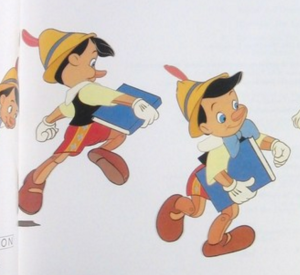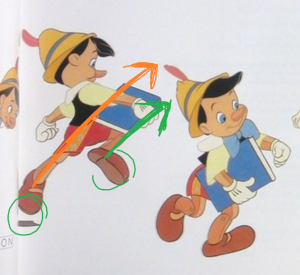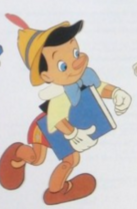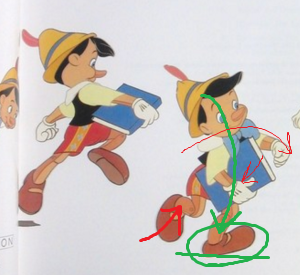After looking through some of the book “Illusion of Life,” that Maria lent to me, I started to think about the communication of action through single frame poses. This dates back to mark making and drawn/painted images which supports this connection I am making with animation and historical painting. Many of the examples in the book are obviously still drawings or a sequence of drawings that communicate a moving action. I still had a clear sense of the action that was taking place and the motion of the form just through the sequence of poses.
Here is an example from the title page. We can get a sense of the action and motion that pinocchio is expression just through these series of drawings (juxoposition helps ie: they read left to right and we can compare size, proximity, ect). So if we can read the action and motion at some level here, why do we need to fully animate these actions?

I think the answer lies in time. Another book called “Timing for Animation,” focuses on the concept of the moving image through time. For example, we can read the above motion of skipping with the posed sequence of drawings.. but what we DONT get is a sense of time. Time is essentially non-existent in this series of poses and open to interpretation from any viewer. Pinocchio could be skipping very fast or very quickly, or perhaps has a specific pattern and tempo to his paces. I want to do some more digging into this official explanation of how time works and perception, but for now I want to explain how I am interpreting timing and poses just from my own thoughts. The following is the process of how I would break down and interpret an image and the suggested illusions of motion accompanying.
Motion From Pose
The motion depicted in still images and even time based media is just an illusion, we all know that. Our mind craves completion and is very good at filling in gaps. Naturally, when we are presented with even just two images, we want to form a relationship between them and from this relationship, we can interpret movement.
This is evident in the pinocchio sequence:

It’s discernible that the character is in the middle of a springy stride in the left pose. This is because his trailing foot is off the ground a bit, his leading foot is very bent in pointed in a direction parallel to this trailing foot, suggesting that his leading foot is the source of momentum aka, his line of action communicates his movement and momentum carrying him up and forward.

On the next pose we can interpret that he is landing. However, we need the previous left post to create this conclusion. Here’s what is looks like if we have just the right frame:

Does’t it sort of look like he is throwing a punch? Comical but surprising how this pose is read completely differently just by isolating it. Without the previous pose to reference, it is very difficult to read any motion or action correctly. The power of the “gap fill” by the mind is very evident here.
Now with the comparison again:

The line of action (green) changes from swooping up to curving down into the foot that is touching the ground and holding his weight now. Another thing that I compare in poses is the direction of displacement. This is marked in red, and you can see how his trailing foot moves up a bit, and his arms swing. It is interesting to see how the green line of action shows his current state of balance and pose, while the red lines of displacement reference the momentum and actions that come before and possibly after this pose, which in this case is carying through in a potential sideways direction and upward direction.
Quality from Time
This pair of drawings can give us a decent understanding of the verb, the action that the character is performing. However, there is not enough information to tell us the adjective, how the action is being carried out. Is Pinocchio skipping quickly? Slowly and defying normal gravity? Is his hang time in the air significantly more than ground time? As poses describe the type of action and motion, its really the timing that describes the quality of the motion. Granted, we can get some sense of different physical attributes that may effect the quality of motion like, for example, his head. In the second pose, even though Pinocchio has reached the ground and his body is more crunched and bound with potential energy ready to pounce back up, his head is trailing behind. It is trailing even in both poses. An experienced viewer would most likely interpret this as a heavy part of the body, and expressed through the overlapping and follow through principle. If Pinocchio’s head is very heavy it would be trailing, trying to keep up with the motion of the rest of the body because it is involved with more momentum. I would anticipate the head really snapping down and forward in a following pose as the rest of the body is projected forward and up. The head is delayed because its weight is just now reacting from the body’s downward motion.
So even though we know what action Pinocchio is expressing, we aren’t entirely sure of how he is expressing it. Time is the deciding factor in that aspect. If we had enough drawings side by side, we could probably get a decent idea of time. Even though, as mentioned before, some may read over the drawings at a different rate and time is ultimately decided by the viewer, our mind can still interpret time through space. If there is a ball bouncing, we can interpret the spacial relationship as a depiction of speed and time.

This velocity/displacement relationship is basically just the foundation for time based media. Displayed as single frames, more displacement between frames equals greater velocity. Knowing this, I think our minds notice this pattern and repetition and naturally want to read each interval as an equal unit of time. So after all this rambling and animation jargon what does this mean?
I am starting to form some relationships with still-frame poses and renaissance paintings. Both make use of poses and gestures to communicate some type of action, but it is essentially time that communicates the quality. As I explained above, to provide any sense of time there needs to be more poses giving context and comparison to one another. Motion really seems like an observation and comparison of the displacement of the visual. If there is no displacement or even comparison, there is no motion. Perhaps the use of motion and timing isn’t so much used to explain “the statue is moving slowly” or “fiercely.” I think its more of making that initial action more clear. Before motion and time can be introduced, I need to take the next step from poses to sequences. Right now, a painting is in the stage of the still frame Pinocchio that could be mistakenly interpreted as punching… The next step isn’t really a full fledged animation, its an image sequence to provide comparative views of action poses.
Next, I’m going to be performing a brief analysis on a painting that implies motion to apply this loose concept acquired from the interpreted text.





